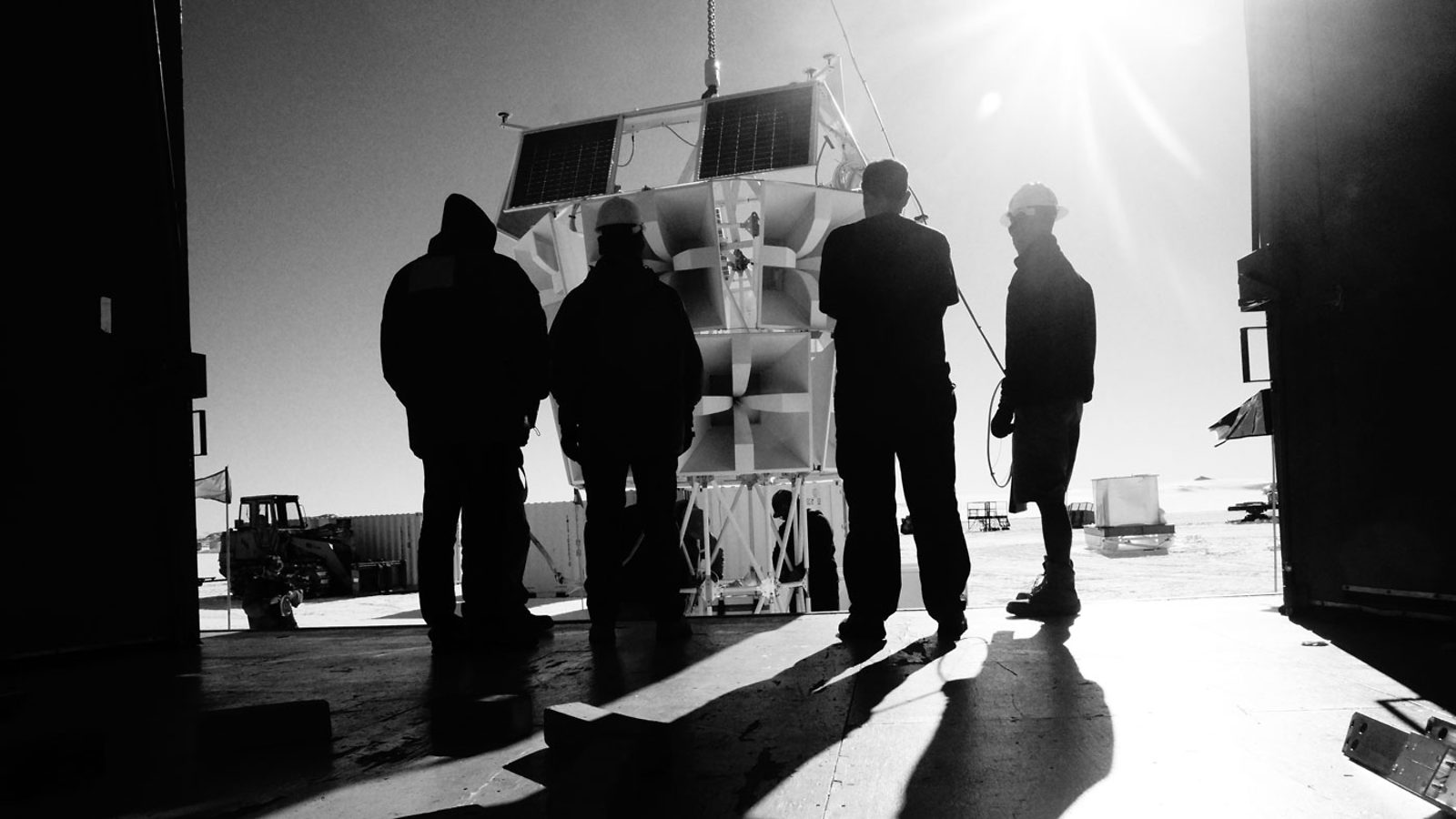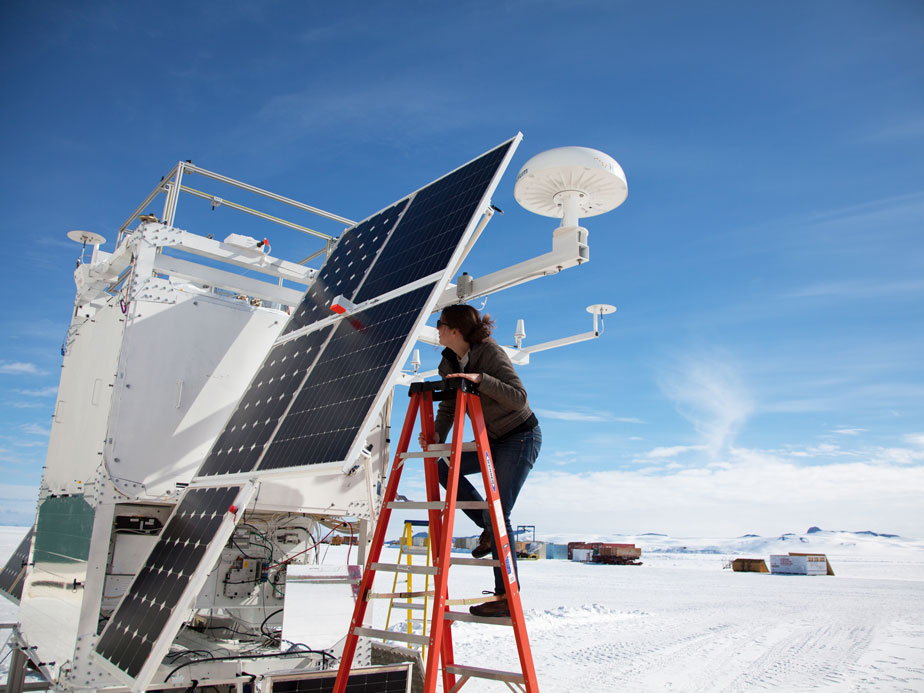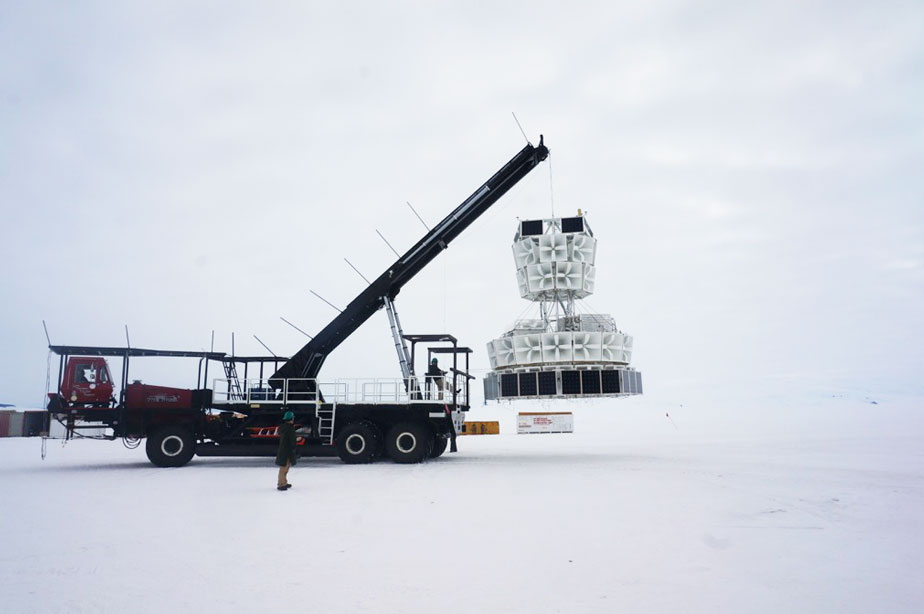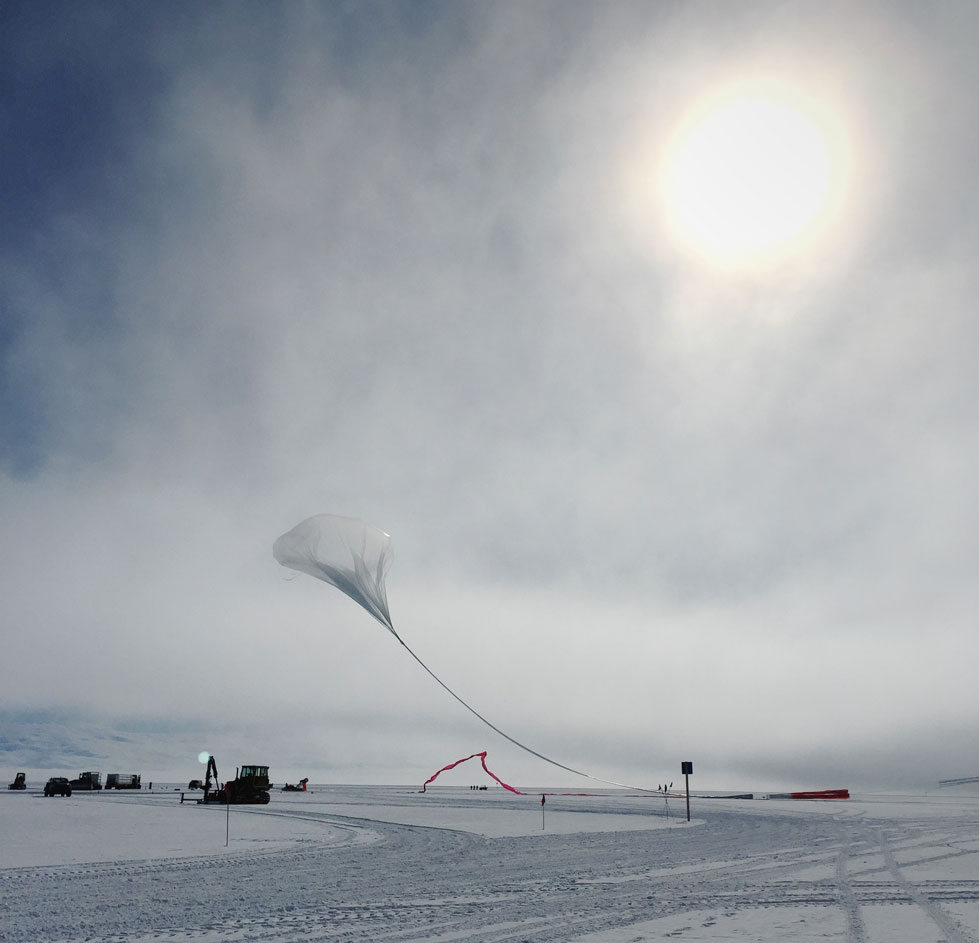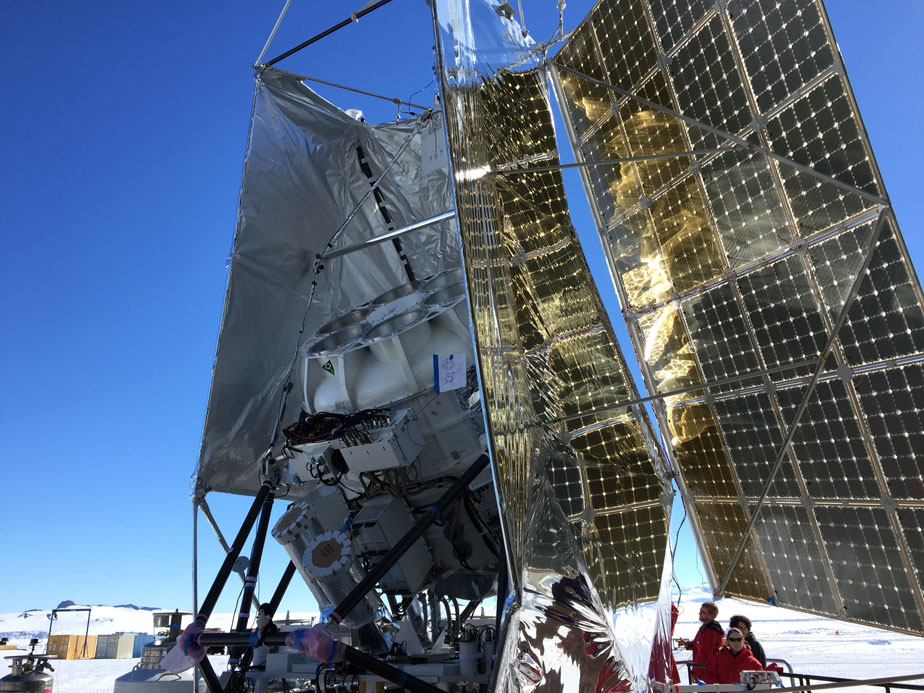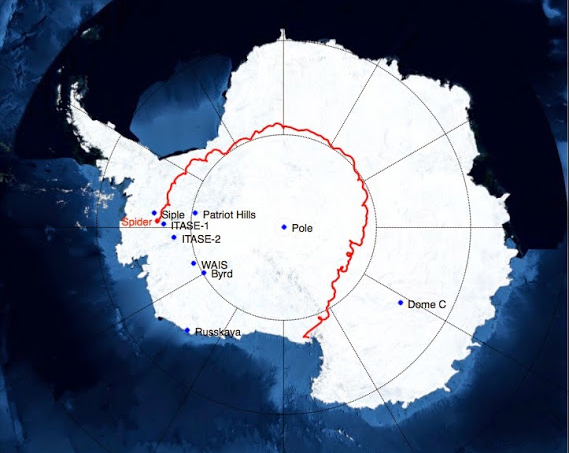UC Berkeley grad student Carolyn Kierans recently watched her 5000-pound astrophysics experiment ascend 110,000 feet over Antarctica on the end of a helium-filled balloon the size of a football field.
She had been up since 3 a.m. with the team that prepped and transported the telescope known as COSI—Compton Spectrometer and Imager—across the ice shelf on an oversized vehicle called “The Boss.” They waited hours at the launch site in a thick fog for the winds to die down before getting the go-ahead to fill the balloon.
Then the sky opened up, and they were cleared for launch.
“I was with the crew at the launch pad, in the middle of nowhere, when the clouds disappeared and I could finally see the balloon hundreds of feet up,” she recalls. “I had to stop and say, ‘Wait, I’m doing my PhD in physics right now?’”
Kierans was among three groups of hardy physicists who met up at Antarctica’s McMurdo Station last fall to fly their curious-looking instruments during NASA’s most recent Antarctic Scientific Balloon Campaign.
For Antarctica’s three summer months, December through February, conditions are right to conduct studies in the upper atmosphere via scientific balloon. The sun never sets during those months, so the balloons are spared nighttime temperatures that would cause significant changes in altitude. And seasonal wind patterns take the balloons on a circular route almost entirely over land.
To allow the balloons enough time to collect data and safely land before conditions change, all launches must take place within a few weeks in December. Near the end of 2014, three teams of physicists arrived at the end of the Earth to try to launch, one after the other, within that small window.
Each team was driven by a different scientific pursuit: COSI set out to capture images of gamma rays for clues to the life and death of stars; ANITA (Antarctic Impulsive Transient Antenna) sought rare signs of ultra-high-energy neutrinos; and SPIDER was probing the cosmic microwave background for evidence of cosmic inflation.
Months of intense preparation, naps on the floor of a barn, competition for launch times during narrow windows of opportunity, and numerous aborted attempts did not dampen spirits. The teams shared meals, supplies, hikes and live music jams with locals at one of two town bars—united by the common pursuit of physics on high.
“The community was like a gigantic family with the same goal of getting those balloons up,” Kierans says.
None could be sure of a successful launch. Nor could they know exactly when or where their balloon would land once it took flight or how they would navigate the icy landscape to retrieve their precious data.
‘The crinkling of Mylar’
Balloon-based physics experiments take many months of preparation. The teams first met up during the summer at the Columbia Scientific Balloon Facility in Palestine, Texas, where they assembled payloads and tested science and flight systems. Then they disassembled their experiments, shipped them in boxes and put them back together at McMurdo starting in October to be launch-ready by early December. Each group had 10 to 20 team members on the continent during peak work efforts.
“We had about eight weeks to get everything back together and perform all the calibrations—it’s an exhausting and stressful period—and a very long time to be away from family,” recalls William Jones, assistant professor of physics at Princeton University and SPIDER lead.
A successful launch depends on the optimal functioning of gear and instruments—and the cooperation of the weather.
First in line was the ANITA experiment. ANITA hunts for the highest energy particles ever observed. Scientists have known about ultra-high-energy neutrinos since the 1960s, but they still don’t know exactly where they come from or how they get their energy.
“Nothing on Earth can produce such particles right now,” says Harm Schoorlemmer, a postdoctoral fellow at the University of Hawaii from the ANITA team. “They are five to seven orders of magnitude higher in energy than particles we can accelerate in machines like the LHC at CERN.”
Neutrinos travel through the universe barely interacting with anything—until they hit the dense Earth. ANITA’s 48 antennas on a 25-foot-tall gondola fly pointed down to capture radio waves in the Antarctic ice—signs of ultra-high-energy neutrino reactions.
“The ice sheet has the advantage that it is transparent for radio waves,” says Christian Miki, University of Hawaii staff scientist and ANITA on-ice lead. “By flying high—about 120,000 feet up—ANITA can capture a diameter of 600 kilometers all at once.”
Numerous ANITA launch attempts were scrubbed due to weather. It took several hours from hangar to launch at the Long Duration Balloon Facility, and Antarctic weather is known for radical shifts within the hour, Miki says.
The day before the actual launch, the payload had been brought out of the hanger and checks were being performed when the team noticed an Emperor penguin hanging out on the edge of the launch pad. “We thought this was either good luck—getting a blessing from the Antarctic gods—or bad luck as penguins are flightless birds,” Miki recalls.
Apparently graced, the ANITA team rolled out on December 18 for the real deal. The 4944-pound experiment was loaded onto the The Boss and taken to the launch site. Hours passed as they waited for optimal conditions; all the instruments were checked and double-checked. Finally, they got the go-ahead from NASA.
“It’s hard to grasp the scales involved,” Schoorlemmer says. “The balloon is 800 to 900 feet above The Boss before the line is cut—buildings are about 35 to 40 feet tall. It takes one and a half hours to fill the balloon with helium, and then everything goes quiet. All we could hear is the crinkling of the Mylar and people going ‘Ooh, ooh.’”
Hunting gamma rays
Next up was COSI, a wide-field gamma-ray telescope that studies radiation blasted toward Earth by the most energetic or extreme environments in the universe, such as gamma-ray bursts, pulsars and nuclear decay from supernova remnants. Because gamma rays don’t make it through the Earth’s atmosphere, the telescope must rise above it. Pointed out to space, it can survey 25 percent of the sky at one time for sources of gamma-ray emissions and help detect where these high-energy photons come from. Researchers hope to use its images to learn more about the life and death of stars or the mysterious source of positrons in our galaxy.
Testing gamma ray telescopes like COSI on balloons can help scientists develop technologies that can eventually be used on satellites. The recent COSI launch was the first to use a new ultra-long-duration balloon design in hopes of getting 100 days worth of data.
COSI was launch-ready at the same time as ANITA but waited for it to go up before preparing to do the same. They also experienced several attempts called off due to weather.
“For nine days in a row, we showed up and did all the prep work,” only to abandon the efforts, Kierans says. On one attempt they got as far as laying out the balloon, which was theoretically the point of no return, before the weather turned against them. They somehow managed to put the 1.5-millimeter-thick, 5000-pound balloon back into the box. “It took 10 riggers over an hour of strenuous, delicate work” to put it back, Kierans wrote on her blog.
Finally, on December 27 the silvery white balloon was filled with helium and cut loose, taking COSI up to the dark space above the Earth’s atmosphere.
Jubilation at the successful launch did not last long. Just 40 hours later, a leak in the balloon forced the team to bring it back down. “It will be tough to get science data out of that short flight,” Kierans says. “But we will learn a lot. We made the decision to bring it down where we could get everything back and rebuild.”
COSI was fully recovered by Kierans, who made three trips by twin otter plane to the Polar Plateau just over the Transantarctic Mountains—known as the “great flat white”—to disassemble and load up the instruments.
Every inch of their flesh was covered to prevent frostbite. “This was not what I signed up for when I started out in physics,” she says. “But don’t get me wrong—I love it!”
Big sky, big bang
Last in line was SPIDER, which uses six telescopes designed to create extremely high-fidelity images of the polarization of the sky at certain wavelengths—or “colors”—of light. Scientists will use the images to search for patterns in the cosmic microwave background, the oldest light ever observed. Such patterns could provide evidence for the period of rapid expansion in the early universe known as cosmic inflation.
Rising 118,000 feet above the Earth, the 6500-pound SPIDER is able to observe over six times more sky than Earth-based CMB experiments like BICEP.
“Large sky coverage is the best way to be able to say whether or not the signal appears the same no matter where you look,” explains Jones, SPIDER lead.
With just days remaining in the launch window after the COSI launch, SPIDER took advantage of a good patch of weather on the last possible day—New Year’s Eve in the US.
The team started out at 4 a.m. with what seemed like perfect weather, but the winds higher up were too fast and the launch was put on hold for about five hours. Eventually the winds died down and SPIDER was back on track to fly.
“The launch, in particular the final few minutes once the balloon filled and released, represents the culmination of over eight years of work. It is a thrill. At the same time it is truly frightening,” Jones says.
Princeton University graduate student Anne Gambrel left this note on the experiment's “SPIDER on the Ice” blog: “Over the next couple of hours, we all huddled around our computers, and as each subsystem came online, working as designed, we all cheered. By 9 p.m., we were at float altitude and nothing had gone seriously wrong. I went home and slept like a rock as others got all of the details sorted and started taking data on the CMB.”
Around and around she goes
During the first 24 hours after their launch, the ANITA team constantly observed and tuned the instruments from the base. “There were six of us rotating in and out of the controls, while others were sleeping in cardboard boxes next to commanders,” Schoorlemmer says.
The balloons are tracked in their circular flight around the continent, watched carefully for the optimal time to call them back to Earth.
“Once the balloon is launched, you only have historical record to guide your intuition about where it will go,” Jones says. “No one really knows.”
ANITA was up in the air for 22 days and 9 hours and was able to collect about twice the data of the experiment’s last polar flight.
The instruments came down near the Australian Antarctic Station on January 9. “The Australians volunteered their services in recovering the instruments. They will go on a vessel up to Hobart and be picked up by the team in spring,” Miki says.
SPIDER flew for about 17 days, generating approximately 85 GB of data each day, mainly from snapshots taken at about 120 images per second.
“It’s a daunting analysis task,” Jones says. But his team will eventually combine the data to make an image of the southern hemisphere representing about 10 percent of the full sky.
SPIDER was brought down on January 17, 1500 miles from launch location “before it could go over the water and possibly not come back,” Jones says.
The SPIDER team received assistance from the British Antarctic Survey in recovering the data. “Our experiment weighed roughly 6200 pounds, and we got back about 180,” Jones says. The rest, including the science cameras and most electronics, will remain on the West Antarctic plateau over the southern hemisphere winter.
Other discoveries
Finally arriving in New Zealand post-recovery, a few of the scientists went to the botanical gardens to lie on the grass.
“To be able to walk barefoot in it!” Miki says. “I remember landing at 6 o’clock in the morning, walking out of the airport and actually smelling plants and the rain.”
While the landscape, the science, the instruments, engineering and logistics of such balloon experiments are impressive, the Antarctic researchers were just as taken with the stalwart souls that make them happen.
“The biggest surprise for me was the people,” Kierans says. “The contractors who work at McMurdo devote half the year to be in the harshest of continents, and they are some of the most interesting people I’ve ever met.”
Miki concurs. “You’d be surprised who you might find working as support staff there. There was a lawyer taking a break from law; PhDs driving dozers. Some are just out of college and others are seasoned Antarctic veterans.”
The staff is as friendly as they are professional, Miki says. “They’ll invite ‘beakers’ (what they call scientists) to parties, knitting circles, hikes, etc. With a peak population of over 900 people living in close quarters, getting along is essential.”
Miki also reflected on the strong friendships made: “Maybe it’s the 24 hours of sunlight, living in close proximity, minimal privacy, long work hours, the desolation in which we are all immersed. Maybe it’s just that the ice attracts amazing, brilliant, talented people from around the world.”
For Jones, the commitment such adventure-ready researchers show to their work goes above and beyond.
“We were always supportive, always competitive, sometimes strained, sometimes ecstatic,” he says. “It’s an honor to be able to work with such talented people who are selflessly devoted to learning more about how Nature works at a fundamental level.”



